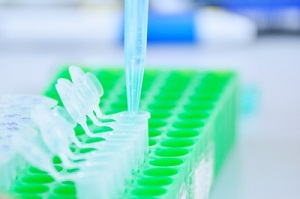Question:
How do you prepare your phosphate buffer?
The Protein Man Says:
 Since biological reactions are extremely sensitive to pH changes, it’s always a good idea to have a phosphate buffer ready in the laboratory. In case you aren’t familiar with them, phosphate buffers are one of the two most important biological buffer systems in most multicellular organisms and are responsible for keeping the pH range of cellular fluid within the normal range (6.9 to 7.4).Since phosphoric acid has multiple dissociation constants, you can prepare phosphate buffers near pH 2.15, 6.86 and 12.32. However, most phosphate buffers are prepared at pH 7.
Since biological reactions are extremely sensitive to pH changes, it’s always a good idea to have a phosphate buffer ready in the laboratory. In case you aren’t familiar with them, phosphate buffers are one of the two most important biological buffer systems in most multicellular organisms and are responsible for keeping the pH range of cellular fluid within the normal range (6.9 to 7.4).Since phosphoric acid has multiple dissociation constants, you can prepare phosphate buffers near pH 2.15, 6.86 and 12.32. However, most phosphate buffers are prepared at pH 7.
Preparing Your Phosphate Buffer
How do you prepare your phosphate buffer? Here's how:
What You'll Need
- Monosodium phosphate, monohydrate and its conjugate base disodium phosphate, heptahydrate
- Water
- Phosphoric acid (to make the buffer more acidic) or sodium hydroxide (to make the solution more basic)
- pH meter, glassware and hot plate with stirring bar
Procedure:
- Decide on the properties of your buffer. Before doing anything, you need to decide on the molarity and pH of your buffer. Remember, most buffers are used at a concentration between 0.1 M and 10 M and the pH should ideally be within 1 pH unit of the acid or its conjugate base.
- Determine your acid-base ratio.To calculate the amount of acid and base that you will need in preparing a phosphate buffer with the desired pH, you need to take into account the three dissociation constants of phosphoric acid. Since H3PO4dissociates into H+ + H2PO4-, the ionization constant can be computed by using the following equation K1 = [H+][H2PO4-] / [H3PO4], or[H2PO4-] / [H3PO4] = K1 / [H+]. The relative amounts are then calculated by normalizing the amounts of each of the four moieties. As such, you can derive the molar amounts of monosodium and disodium phosphate by using the following equations:
Monosodium Phosphate = [H3PO4] + [H2PO4-] and Disodium Phosphate = [PO43-] + [HPO42-]
Simply use the molecular weights of the acid-base conjugate pair and the desired buffer strength to calculate for the actual percentages. Note: It is highly recommended that you prepare a phosphate buffer with a pH close to one of its pKs. - Prepare the solution. Using the calculated ratioderived from the equation, mix the required amounts of acid and base and mix them in approximately one liter of water to prepare a rough buffer solution.
- Check the pH. Use your pH meter and adjust the pH accordingly by using phosphoric acid or sodium hydroxide. Bring the total volume to one liter once you have reached the desired pH.
- Dilute as necessary. Use this stock solution to prepare buffers of different molarities as needed.
Image By - Photokanok






